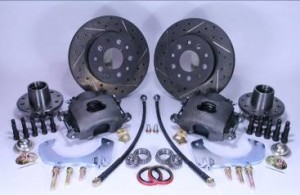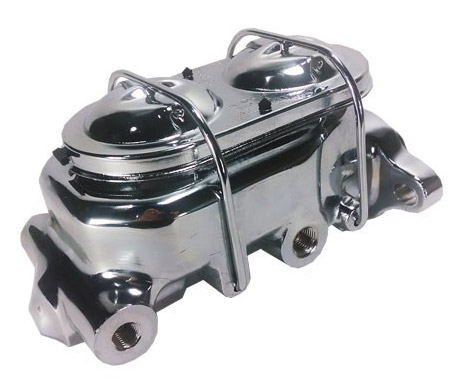The brake master cylinder is a critical component of your vehicle’s braking system. Understanding the role of the master cylinder can help you determine if you want to replace it and what to look for in a replacement.
Let’s take a brief overview of a braking system, then get into detail about the role of the master cylinder. We’ll look at single and dual reservoir cylinders, bore size, and all the components of the master to help you make the best choice for your vehicle.
Braking System Overview
Whether you employ an all-disc system, a disc/drum combination, or an all-drum setup, the role of the master cylinder remains the same.

The act of braking begins when you depress the brake pedal. The master cylinder uses that pressure to push a piston and send hydraulic fluid through the brake lines to each individual brake. Pistons inside of a bore that are located on each of the four brakes, fill with brake fluid and engage the pads or shoes and squeeze against the rotor or brake drum and stop your vehicle.
The brake master cylinder uses the pressure from the brake pedal to push a piston, sending hydraulic fluid through the brake lines.
Simply put, the mechanical pressure exerted on the brake pedal by your foot gets converted into hydraulic pressure by the master cylinder. That pressure sends the fluid through your brake lines and engages the pistons at each of the four wheels, thus activating the brake calipers and slowing or stopping your vehicle.
Single vs. Dual Reservoir Master Cylinders
There are two types of master cylinders: single reservoir and dual reservoir. Single reservoir systems feed both the front and rear brakes from a single reservoir and brake line. Dual reservoir systems have one reservoir feeding the front brakes while the second reservoir feeds the rear brakes through two completely separate brake lines.
The failsafe of the dual reservoir master cylinder ensures that, in the event of a malfunction, your chances of having some working brakes are better than they are with a single reservoir master.
Bore Size
In addition to the reservoirs, the function will be affected by bore size. Bore size can range from 7/8” to 1-1/4” and will affect pedal travel distance and effort. In other words, a smaller bore size will increase pressure and decrease the amount of effort required by you to stop your vehicle.
“Decreasing master cylinder bore size will decrease your pedal effort and increase your pedal travel. Conversely, a larger bore in your car’s master cylinder will, with all other components being consistent, increase your pedal effort and decrease your pedal travel. As with some other brake parts purchases, this comes down to your preference for how the brakes “feel” underfoot when you are driving.”
– Master Power Brakes Tech Team
Components of a Master Cylinder
Now that we know the two main types, let’s delve into the main parts of the master and how it works to regulate your braking system.
1. Reservoirs
The reservoir, or reservoirs, are used to house the brake fluid. In a dual reservoir system, the reservoirs can be of equal size but in other master cylinders, one of the reservoirs might be smaller. No matter the size, one of the reservoirs feeds the front brakes, while the other reservoir feeds the rear brakes. It does matter which of the reservoirs is used to feed the front or rear and that is dependent on the actual master cylinder as there is not standard.

2. Piston
Machined into the center of the master cylinder body is the actual bore of the master cylinder which houses the pistons. The pushrod from the brake pedal or the booster pushes against the piston housed inside this bore. When the pedal is pressed, the piston is moved inside the bore and pulls fluid from the reservoir, and compresses that fluid thus creating hydraulic pressure for the rest of the system. The harder the pedal is pushed and the further the piston travels will create more line pressure.
3. Spring
The spring is a component inside the master cylinder bore that provides resistance when applying the brake pedal and also allows the piston and brake pedal to return to their original position after the brakes are no longer engaged.
How Do You Know When the Brake Master Cylinder Has Gone Bad?
There are internal and external seals inside the master cylinder. The breakdown of these seals over time results in brake fluid leaks outside of the unit or brake lines. Typically, if your master cylinder needs to be replaced, your brake pedal will feel mushy or spongy. In some cases, the brake pedal will even drop or fall to the floor when the vehicle comes to a complete stop.
Features to Consider
In addition to bore size, which is typically selected based on brake type, consider which side of the master cylinder would be ideal for port location when placing and installing the master. An adjustable pushrod attachment may work for your vehicle as well.
Customer Example: 1969 Ford Mustang with 4 Wheel Disc Brakes
Not long ago, we received a request for help from the owner of a 1969 Ford Mustang. He was looking for a Ford master cylinder to use for his 4-wheel disc brakes set up.
In this case, with the manual disc brakes both front and rear on the customer’s ’69 Mustang, we recommend MPB part number MC11378M. This master cylinder has a 1″ bore and ports on the left-hand side of the master cylinder, which should work well for his vehicle.
This specific master cylinder has been greatly successful and used by many of our customers who drive four-wheel disc cars, as measured by vehicle owners reporting comfortable brake pedal travel and required pedal effort along with our own testing of components on a vehicle.
A braking system’s master cylinder is a critical component that transfers the physical force into hydraulic force, sending brake fluid through the brake lines to engage the calipers and stop your vehicle. It’s important to consider master cylinder size, port placement, and bore size when choosing the one that will fit your car the best.
Need help? Contact Us
As you can see, there are other vehicle-specific factors to consider when selecting your new master cylinder. If you’re confused or torn between several options, please drop us a line. We’d be happy to help you figure out what part will be best for you.
Contact a Master Power Brakes Tech Expert
